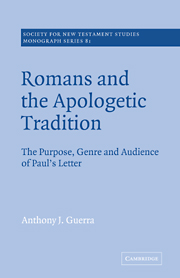Book contents
- Frontmatter
- Contents
- Preface
- List of abbreviations
- 1 Apologetic and audience: making the message meet
- 2 Apologetic motifs in Romans 1.18–3.31
- 3 Romans 4: the continuation of apologetic argumentation
- 4 Paul recommends and defends the gospel of God
- 5 Romans 9–11: Paul defends his mission to the Gentiles for the sake of the Jews
- 6 Romans 12–13 and 16: the “Roman factor”
- 7 Summary and conclusion
- Appendix
- Glossary
- Select bibliography
- General index
- Index of modern authors
1 - Apologetic and audience: making the message meet
Published online by Cambridge University Press: 17 August 2009
- Frontmatter
- Contents
- Preface
- List of abbreviations
- 1 Apologetic and audience: making the message meet
- 2 Apologetic motifs in Romans 1.18–3.31
- 3 Romans 4: the continuation of apologetic argumentation
- 4 Paul recommends and defends the gospel of God
- 5 Romans 9–11: Paul defends his mission to the Gentiles for the sake of the Jews
- 6 Romans 12–13 and 16: the “Roman factor”
- 7 Summary and conclusion
- Appendix
- Glossary
- Select bibliography
- General index
- Index of modern authors
Summary
In this chapter, two interrelated interpretive hypotheses concerning Paul's letter to the Romans are presented, namely that the letter is a Пροτρεπτικòς Λóγος or a Protreptic, and that this Protreptic is directed to an audience comprised in significant part of Jewish Christians. The denial of a significant presence of Jewish Christians in Paul's Roman audience has been argued on both textual and circumstantial grounds and both rationales will be shown to be seriously deficient. Moreover there is a reigning theory among commentators, to the effect that Paul wrote the letter to the Romans as a dress rehearsal for the speech which he intended to give on his upcoming visit to Jerusalem. This proposal has plausibility mainly because the contents of the letter strongly suggest that Paul is addressing Jewish Christians, yet such are excluded from the Roman community by many commentators. Once the reasons for denying that Jewish Christians are part of Paul's audience are found wanting, then the Jerusalem speech hypothesis is readily seen to be untenable. As to the protreptic character of the letter to the Romans, there has generally been surprisingly scant attention paid to the question of the genre of Romans in the history of Romans scholarship. In his revised and expanded The Romans Debate, Karl Donfried seems to be correct in asserting that it is too early to celebrate a consensus concerning the rhetorical character of Romans.
- Type
- Chapter
- Information
- Romans and the Apologetic TraditionThe Purpose, Genre and Audience of Paul's Letter, pp. 1 - 42Publisher: Cambridge University PressPrint publication year: 1995



